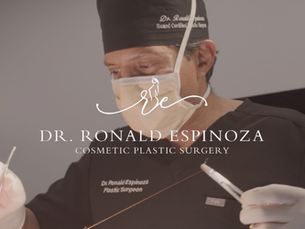top of page

All Posts


Discover the Full Range of Cosmetic Surgery Procedures
Considering breast implants? Learn the key differences between saline and silicone implants to make an informed decision. This guide by Dr. Ronald Espinoza highlights feel, safety, cost, and aesthetic results for each option.
Dr Ronald Espinoza
5 hours ago4 min read


Silicone and Saline Implants: Choosing the Right Option
When considering breast augmentation, two main options present themselves: silicone and saline implants. Each type has its unique...
Dr Ronald Espinoza
1 day ago3 min read


Enhance Your Curves Naturally with a Brazilian Butt Lift (BBL)
A Brazilian Butt Lift (BBL) uses your own body fat to enhance buttock shape and volume while sculpting donor areas, providing a natural, rejuvenated silhouette. Learn everything you need to know about BBL with renowned plastic surgeon Dr. Ronald Espinoza.
Dr Ronald Espinoza
2 days ago4 min read


Saline vs. Silicone Implants: Which Is Better for Your Breast Augmentation in NYC?
Saline and silicone implants each offer unique benefits depending on your aesthetic goals and preferences. Understanding their differences can help you make an informed decision about your breast augmentation journey.
Dr Ronald Espinoza
2 days ago3 min read


Hooded Eyes Correction NYC & Miami | Blepharoplasty Guide by Dr. Ronald Espinoza
Hooded or sagging eyelids can affect both appearance and vision. Blepharoplasty with Dr. Ronald Espinoza provides a precise, effective solution for rejuvenating your upper eyelids with minimal downtime.
Dr Ronald Espinoza
Jul 174 min read


Did Lindsay Lohan Have a Facelift? Uncovering the Truth Behind Her Glow
Lindsay Lohan’s radiant transformation has sparked facelift rumors—but is surgery really the reason? Discover what’s behind her glow, from wellness to non-invasive treatments.
Dr Ronald Espinoza
Jul 163 min read


Do I Need an Arm Lift? Signs You Might Be Ready for Brachioplasty in NYC
If you struggle with sagging skin or stubborn fat in your upper arms, an arm lift by Dr. Ronald Espinoza can restore a sculpted, youthful appearance. Discover how this transformative procedure can enhance your confidence.
Dr Ronald Espinoza
Jul 154 min read


Diosa Surgery: The Breast Augmentation Behind "La Reina de la Radio de NY"
Univision radio personality Diosa Caro underwent a breast augmentation with Dr. Ronald Espinoza—an expert in creating natural, camera-ready results. Her “Diosa Surgery” look has since become a beauty inspiration for thousands.
Dr Ronald Espinoza
Jul 154 min read


What Is a Brazilian Butt Lift?
Looking for the best BBL in NYC or Miami? Dr. Ronald Espinoza, a double board‑certified surgeon, provides natural, lasting curves using advanced fat‑transfer techniques. Explore benefits, cost, recovery, and why he's a top choice.
Dr Ronald Espinoza
Jul 114 min read


How to Get a Glow Up: Your Complete Guide to Radiant Transformation
Ready to glow up? Follow these practical tips for radiant skin, healthy habits, mindset shifts, style boosts, and expert procedures by Dr. Ronald Espinoza for a complete transformation.
Dr Ronald Espinoza
Jul 103 min read


Facelift Fever: Why Celebrities Like Jennifer Aniston, Salma Hayek & Halle Berry Choose Natural Facelifts
The natural facelift is redefining what it means to age gracefully. Explore how Dr. Ronald Espinoza’s advanced techniques are helping patients achieve a refreshed, youthful appearance with no obvious signs of surgery.
Dr Ronald Espinoza
Jul 94 min read


Why the Cost Matters in NYC: Understanding Breast Augmentation Prices
Planning a breast augmentation in NYC? Get an in‑depth look at total costs, influencing factors, non‑surgical alternatives, and financing resources—so you can move forward informed and empowered.
Dr Ronald Espinoza
Jul 44 min read


How to Get Rid of FUPA in NYC — Safe and Affordable Surgery for a Flatter Lower Abdomen
Discover safe and affordable surgical options to get rid of FUPA in NYC with Dr. Ronald Espinoza. Achieve a slimmer, firmer lower abdomen with liposuction or mini tummy tuck procedures tailored to your needs.
Dr Ronald Espinoza
Jul 43 min read


Rhinoplasty Miami & Rhinoplasty NYC: Natural Nose Perfection with Dr. Ronald Espinoza
Seeking expert rinoplastia Miami or rinoplastia NYC? Dr. Ronald Espinoza offers personalized nose reshaping with natural results, digital planning, and top-tier aftercare in Miami and New York.
Dr Ronald Espinoza
Jul 14 min read


Kris Jenner Facelift Controversy: What's Real and What's Filtered?
Kris Jenner's recent appearance has sparked massive debate online: is it a facelift or filtered fantasy? We break down the facts behind her dramatic new look, explore the role of plastic surgery in high-profile transformations, and highlight why choosing a board-certified expert like Dr. Ronald Espinoza is essential.
Dr Ronald Espinoza
Jun 304 min read


How to Sleep After a Tummy Tuck: Essential Tips for a Smooth Recovery
Learn how to sleep after a tummy tuck to ensure a safe, comfortable, and speedy recovery. Dr. Ronald Espinoza shares expert guidance for patients in NYC and Miami.
Dr Ronald Espinoza
Jun 263 min read


How Much Does Rhinoplasty Cost in NYC? Discover Affordable Nose Surgery with Dr. Ronald Espinoza
Curious about rhinoplasty cost in NYC or Manhattan? Discover how Dr. Ronald Espinoza delivers natural-looking nose jobs with transparent pricing, flexible financing, and exceptional results.
Dr Ronald Espinoza
Jun 252 min read


What Are Hooded Eyes? Understanding the Causes and Solutions in NYC
Wondering what hooded eyes are and how to treat them? Discover Botox, fillers, eyelid surgery, and brow lift options in NYC with Dr. Ronald Espinoza.
Dr Ronald Espinoza
Jun 243 min read


How to Get a Flat Stomach in NYC: Affordable Tummy Tuck Surgery by Dr. Ronald Espinoza
Searching for how to get a flat stomach in NYC? Discover how Dr. Ronald Espinoza offers affordable tummy tuck surgery with natural results, clear pricing, and flexible financing.
Dr Ronald Espinoza
Jun 234 min read


Best Rhinoplasty NYC: Achieve Natural Results with a Top Board-Certified Surgeon
Discover how Dr. Ronald Espinoza, top board-certified plastic surgeon in NYC, delivers natural rhinoplasty results tailored to your unique facial features. Learn about types of nose reshaping, cost, and recovery.
Dr Ronald Espinoza
Jun 192 min read
bottom of page
